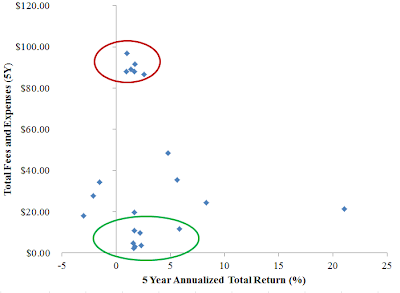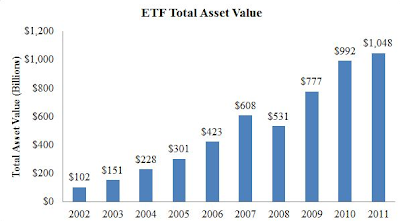SPIVA Scorecard Year-End 2011
(Mar 2012)
S&P recently released their semiannual report comparing the performance of actively managed mutual funds against their appropriate benchmark indices. The S&P Indices Versus Active Funds (SPIVA) Scorecard contains information the mutual fund industry would likely prefer to be kept quiet.
The Year-End 2011 SPIVA Scorecard reports that "over a five-year horizon[...] a majority of active equity and bond managers in most categories lag comparable benchmark indices." Actively managed mutual funds...
Which Would You Rather Have?
(Mar 2012)
Last month we had a blog post introducing the FINRA Mutual Fund Expense Analyzer tool. In this post we apply it to the 25 largest mutual funds and ETFs measuredby net asset value using data from Morningstar. We assumed for this calculation an initial investment of $1,000 held for five years, and plot the total fees and sales charges over that period against the historical 5 year annualized total return of the fund:
There is no clear linear relationship between returns and fees as depicted in...
Greg Smith Leaves Wall Street
(Mar 2012)
The New York Times published an op-ed by Greg Smith, a Goldman Sachs' Executive Director who is resigning from his job after almost 12 years with the firm because, as he puts it, the firm's culture has veered far from what it was when he first joined the firm. He says in spite of the firm's recent scandals "the interests of the client continue to be sidelined in the way the firm operates and thinks about making money." At SLCG, we have come across many examples of the issues raised by Mr....
SLCG Research: Non-Traded REITs
(Mar 2012)
We've posted a new working paper on our website that brings together much of our research related to non-traded Real Estate Investment Trusts (REITs). In it, we discuss the history and structure of non-traded REITs as well as differences between non-traded REITs and other avenues for gaining exposure to real estate. We highlight the dizzying array of fees and conflicts of interest embedded in these companies. We demonstrate that non-traded REITs are often misleadingly valued, heavily...
WSJ on Innovation in Commodity ETFs
(Mar 2012)
Yesterday the Wall Street Journal ran an article about recent innovation in the commodity ETF space. Our work on commodity ETFs has focused on their use of constant-maturity rolling futures strategies, which incur a roll yield depending on conditions in the futures markets. Now, according to the WSJ, many ETF issuers are choosing more complex strategies to try to mitigate these and other effects in commodities markets:
Some of these new products use complex formulas to identify commodities...
Time to Call for More Transparency in ETF Market
(Mar 2012)
Exchange-traded funds (ETFs) started as a "plain vanilla" product: a type of low-fee, tax-efficient mutual funds holding index-mimicking portfolios. The first ETF was formed by the Toronto Stock Exchange in the 1980s and has garnered spectacular popularity in recent years. According to a recent article in The Economist, the number of ETFs in America has almost tripled from its 2006 level of 343 to 1,098 in December 2011. This volume increase has been accompanied by substantial financial...
Mutual Fund Expense Analyzer: A Tool for Calculating Mutual Fund Fees and Expenses
(Feb 2012)
Every mutual fund investor should know how important fees and expenses are in determining the net return of his investment. Compared with other factors affecting a mutual fund's or an Exchange Traded Fund (ETF)'s return, such as market returns, fees and expenses are more stable over time and it is therefore easier to predict their effect on a fund's future performance. However, comparing fees and expenses across funds can be tedious and confusing, as different funds can use different fee...
Should You Cash Out Your Home Equity to Find Your Missed Fortune? Careful! A Scam Might Be On the Way
(Feb 2012)
As a result of a lifetime of thrift, many homeowners find themselves in their 50s and 60s with considerable equity in their homes. Some investment advisors and insurance salesmen have been recommending that these homeowners refinance their mortgages to take the equity out of their homes - sometime called "equity harvesting" - to purchase high cost insurance contracts or investments. Whether insurance contracts or high cost investments are being pitched, the advisors and brokers get a big pay...
ETFs' Asset Value is Increasing, Trading Volume Remains Stable
(Feb 2012)
Financial Times reports that the daily trading volume in the 50 most traded US ETFs in this January and last December was at its historical lows, dropping to the level of the end of 2007. This is surprising since over the past decade the total asset value of ETFs have increased from its 2002 level of $102 billion to just over $1 trillion in 2011 according to the Investment Company Institute. Below we plot the ETF total asset value over the last decade.
Intuitively, one would expect as asset...


